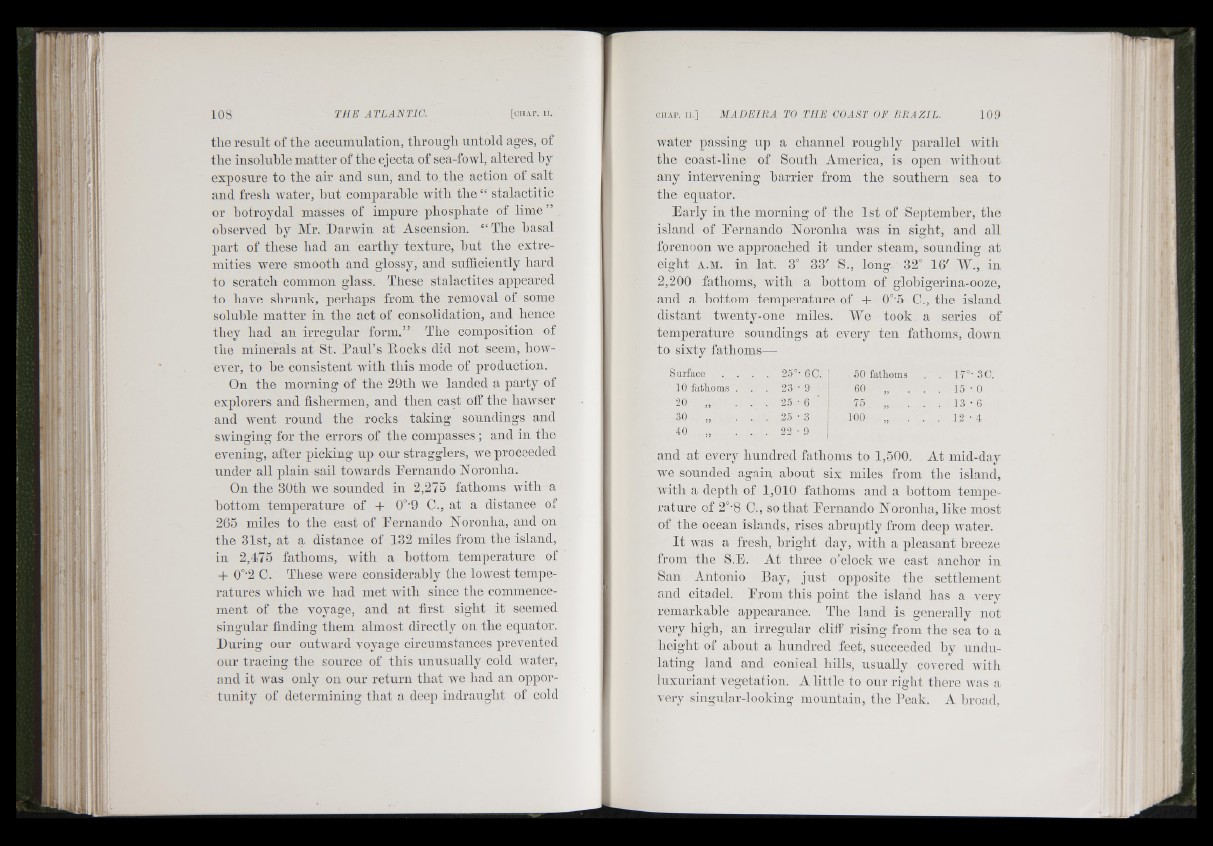
: ' Ì
■ Í
■ N * V
J : > (1.1
.
II
f , i ! „ .
the result of the accumulation, through untold ages, of
the insolnhle matter of the ejecta of sea-fowl, altered hy
exposure to the air and sun, and to the action of salt
and fresh water, hut comparahle with the “ stalactitic
or hotroydal masses of impure phosphate of lim e”
observed hy Mr. Darwin at Ascension. “ The basal
part of these had an earthy texture, hnt the extremities
were smooth and glossy, and sufficiently hard
to scratch common glass. These stalactites appeared
to have shrunk, perhaps from the removal of some
soluble matter in the act of consolidation, and hence
they had an irregular form.” The composition of
the minerals at St. Paul’s Rocks did not seem, Iio a v -
ever, to he consistent with this mode of production.
On the morning of the 29th Ave landed a party of
explorers and fishermen, and then cast off the hawser
and AA'ent round the rocks taking soundings and
SAA'inging for the errors of the compasses ; and in the
evening, after picking up our stragglers, Ave proceeded
under all plain sail towards Pernando Noronha.
On the 30th Ave sounded in 2,275 fathoms with a
bottom temperature of -I- 0“*9 C., at a distance of
265 miles to the east of Pernando Noronha, and on
the 31st, at a distance of 132 miles from the island,
in 2,475 fathoms, Avith a bottom temperature of
-i- 0°'2 C. These Avere considerably the lowest temperatures
AA'hich Ave had met AA'ith since the commencement
of the voyage, and at first sight it seemed
singular finding them almost directly on the equator.
During our ontAvard A'oyage circumstances prevented
our tracing the source of this unusually cold AA'ater,
and it Avas only on our return that Ave had an opportunity
of determining that a deep indraught of cold
■n
water passing up a channel roughly parallel witli
the coast-line of South America, is open Avithout
any intervening harrier from the southern sea to
the equator.
Early in the morning of the 1st of September, the
island of Eernando Noronha was in sight, and all
forenoon we approached it under steam, sounding at
eight A.M. in lat. 3° 33' S., long 32° 16' Mb, in
2,200 fathoms, with a bottom of glohigerina-ooze,
and a bottom temperature of -f 0°'5 C., the island
distant twenty-one miles. We took a series of
temperature soundings at every ten fathoms, down
to sixty fathoms—
S iirface . .
10 fathoms .
20 „ .
30 „
40 „
25°’ 6C.
23 • 9
2 5 - 6
25 • 3
22 • 9
50 fatlioms
60 „ .
75
100 „ .
17°- 3C.
15 • 0
13 • 6
12 • A
and at every hundred fathoms to 1,500. At mid-day
AA'e sounded again about six miles from tbe island,
Avitli a depth of 1,010 fathoms and a bottom temperature
of 2°-8 C., so th a t Eernando Noronha, like most
of the ocean islands, rises abruptly from deep Avater.
I t Avas a fresh, bright day, Avith a pleasant breeze
from the S.E. At three o’clock aa'c cast anchor in
San Antonio Pay, ju st opposite tbe settlement
and citadel. Erom this point tbe island lias a very
remarkable appearance. Tbe land is generally not
very liigb, an irregular cliff rising from the sea to a
height of about a limici red feet, succeeded by nndu-
lating land and conical bills, usually covered AAitli
luxuriant A'egetation. A little to our right there Avas a
very singular-looking mountain, the Peak. A broad.